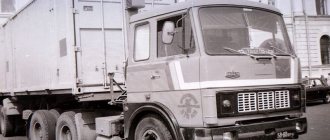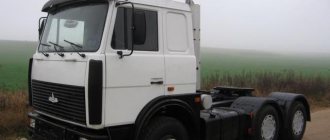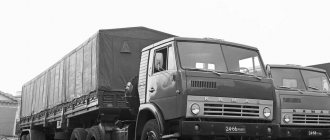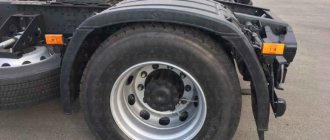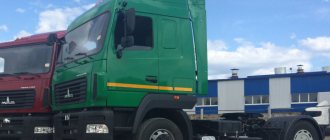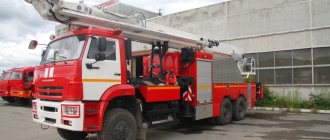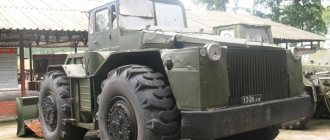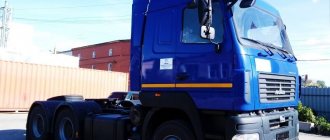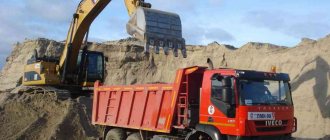Body size zil 131 flatbed
For almost 50 years, the ZIL-131 truck was produced.
It has a large number of different advantages. It was mainly used in the army.
There are many different modifications of this car based on a universal chassis.
Car engine
Despite the fact that the first production model of the car in question was released back in 1966, the technical characteristics of the engine in many areas satisfy the needs of the Russian army even today:
| Parameter name | Characteristic | Units |
| engine's type | Carburetor, four-stroke | |
| Number of working cylinders | 8 | PC. |
| Cooling type | Liquid | |
| Valves | At the top of the engine | |
| Diameter of working cylinders | 100 | mm |
| Working volume of the combustion chamber | 6 | l |
| Piston stroke length | 95 | mm |
| Compression | 6,5 | |
| Maximum engine power | 150 | l. With. |
| Torque at 2,000 rpm | 410 | N×m |
Thanks to its great power and high torque, the ZIL-131 could reach speeds of up to 85 km/h on the highway. Considering the year of manufacture, this parameter can be called quite impressive.
Not every passenger car of those years could move so fast, not to mention trucks of such a large mass.
The fuel consumption of the ZIL-131, shown in the photo on the right, with a mixed driving cycle is 49.5 liters per 100 km at an average speed of 60 km/h.
According to the technical specifications, the engine is designed to work with AI-76 gasoline or a similar one, but with a higher octane number.
Kung and other modifications
The truck model in question turned out to be so successful that a large number of different modifications were produced on its basis.
ZIL-131 KUNG is especially popular. This abbreviation stands for “uniform body of zero overall size.”
Its frame is made of angles and channels of various sizes, sheathed on top with metal sheets.
And here we consider the Grunwald tipper, tilt and semi-trailer container carriers.
The inside of this ZIL-131 van body is lined with foam plastic or other heat-insulating material, after which everything is covered with antiseptic-coated plywood, which improves the technical characteristics of the entire vehicle.
Regardless of their purpose, all KUNG trucks in question are equipped with:
- heating;
- ventilation;
- all kinds of household equipment;
- lighting system (plafonds on the ceiling).
The uniqueness of the ZIL-131 KUNG was the presence in its body of a special filtration unit FVUA-100N-12.
It took air from the environment and disinfected it. Overpressure was created, which made it possible to protect the space inside the van.
The heating system was completely autonomous; heat was generated by burning diesel fuel.
Also, based on the truck in question, the following modifications with good technical characteristics were made:
- ZIL-131NA was equipped with leaky and unshielded equipment;
- ZIL-131V – truck tractor;
- ATZ-3 and similar ones were used as fuel tankers;
- MZ-131 – oil tankers;
- ATs-40 – fire engine.
Weight, dimensions, load capacity
The weight and overall characteristics of the vehicle of this type are relatively small, despite its main purpose. The parameters are as follows:
- curb weight of the model without winch – 6,135 kg;
- curb weight of the model with winch is 6,375 kg.
Although, according to the technical specifications, the weight of the winch mechanism of the ZIL-131 vehicle is quite significant, its presence is always justified, since it allows you to cope with movement in extremely difficult and extreme terrain conditions.
Gross vehicle weight:
- with a winch - 10,425 kg;
- without winch - 10,185 kg.
The maximum load capacity is only 3,500 kg. Also, if necessary, the equipment in question can be used in conjunction with a trailer.
Its permissible weight depends on the road conditions in which the ZIL-131 travels:
- weight when driving on a paved road – 6,500 kg;
- when driving on a dirt road – 4,000 kg.
The basic version of the car has the following overall dimensions:
- length from the front bumper to the rear of the body, mm – 7,040;
- height without awning, mm – 2,480;
- height with awning, mm – 2,975;
- width from left wheel to right, mm – 2,500.
The distance between the wheels is 3.35 m +1.25 m. The width of the front and rear tracks is the same and is 1.82 m. The turning radius is as much as 10.8 m. Considering the length of the body, this parameter is not that great.
The braking distance is 29 m at 50 km/h. The reason for this is the large inertia arising from the mass of the entire car and van with people, as well as all the equipment available.
Chassis design
The chassis of the car in question includes the following main components:
- governance mechanisms;
- chassis;
- main power train (transmission).
ZIL-131 control mechanisms include:
- power steering with mechanical connection to the front wheels;
- braking system.
The chassis includes the following components:
- frame;
- axles on which the wheels are located;
- pendants.
The transmission of this truck is double, its gear ratio is 7.34.
Truck Features
The organ that allows you to use it is located on the dashboard inside the cabin and is a regular metal two-position toggle switch.
Also, the front axle could be turned on using the gear shift lever.
The ZIL-131 gearbox is mechanical in its technical characteristics.
The second and third gears are equipped with special locks. They prevent the speed from being switched off inadvertently if the load on the engine increases rapidly. This is extremely important during a long climb.
For its year of production, the ZIL-131 is equipped with quite advanced electronics.
The design uses an alternator with a large power reserve, as well as contactless ignition with an electronic switching device.
In addition, there is a special vibration device that ensures movement for 30 hours without stopping on its own. All this was new for those years when the car in question began to be mass produced.
Serial production was organized in 1971 at the construction equipment plant in Reutov. Depending on the purpose, and therefore the configuration, AC, ACZ or ATZ were produced. The capacity varied from 4 m3 for steel tanks to 4.4 for aluminum tanks.
From the book by E. Kochnev “Cars of the Soviet Army 1946-1991”, Yauza 2011.
The family of various tank trucks on the ZIL-131 chassis included the simplest dual-purpose models, as well as unified military tankers ATZ-4-131 and ATZ-4.4-131 and an oil tanker MZ-131.
ATs-4.0-131 is a multi-purpose dual-purpose tanker truck on a ZIL-131 chassis with a steel tank with a capacity of 4100 liters and gravity drainage. It was put into service in 1971 and was part of the material support units for storing, transporting and pumping petroleum products. It was equipped with a vortex pump SVN-80 with a capacity of 500 l/min driven from the vehicle’s power take-off, a side control cabin, longitudinal cylindrical canisters or boxes for storing hoses, a pre-cleaning filter and a control system. The total weight of the vehicle is 10,365 kg.
ATs-4.3-131 (АЦЗ-4.3-131) is a dual-purpose refueling tanker truck on a ZIL-131 chassis with a 4300-liter frame tank made of aluminum alloy and a rear control cabin. Entered service in April 1970 and was produced until 1973. It was used for transportation, pumping fuel and simultaneous refueling of up to four units of wheeled or tracked vehicles with measurement of dispensed quantities. The machine was equipped with a SVN-80 vortex pump, a fine filter, two fuel meters-liter meters, pipelines and dispensing hoses with taps, and side canisters for the hoses. All operations are controlled manually from the control cabin installed between the driver’s cabin and the tank. Gross weight – 10,510 kg.
ATZ-4.4-131 - an army tanker on a ZIL-131 chassis with steel? carrier tank with an operational capacity of 4400 l. Entered service on January 21, 1975. In terms of general design and configuration, it was unified with the ATZ-4-131 tanker and served for simultaneous refueling of four consumers.
ATZ-4-131 (ATZ-4.1-131) is a multi-purpose army tanker on a ZIL-131 chassis with a steel tank with a capacity of 4148 liters. It was put into service in July 1976 and was produced from the same year by the Reutov Construction Equipment Plant. In terms of general design and equipment, it was unified with the ATZ-4.4-131 tanker. The curb weight of the vehicle is 7040 kg, the total weight is 10,370 kg.
From the book “Tanks for transporting petroleum products”
Rybakov K.V., Savin V.D., Mityagin V.A. - M.: Transport, 1979
TANK CARS ATs-4,3-131 and ATs-4, 0-131
Tank vehicles AC-4.3-131 and AC-4.0-131 are designed for transportation and temporary storage of petroleum products. ATs-4.3-131 and ATs-4.0-131 are made on the chassis of the ZIL-131 vehicle. In terms of the composition and layout of special equipment, they are similar in basic solutions. The main difference is that the tank and communications of the AC-4.3-131 are made of aluminum alloy AMG-3, and the tank and communications of the AC-4.0-131 are made of St. steel. 3 with subsequent application of an anti-corrosion coating to the inner surface of the tank. The use of aluminum alloy made it possible to increase the capacity of the tank by 300 liters.
The special equipment of tank vehicles includes a tank, a control cabin, canisters, units and components of the hydraulic system, an oil product loading control system, electrical equipment, spare tools and accessories.
Tanks are calibrated and are a measure of total capacity. The tank equipment includes a neck, a sump and a compartment located at the rear of the tank and closed by two doors. A distinctive feature of the tanks is their low neck, and therefore a compensation tank is provided to compensate for the thermal expansion of the transported petroleum products.
Due to design differences, the fastening of tanks to the chassis frame of the ZIL-131 vehicle is also different. The AC-4.3-131 tank is installed through rubber gaskets into special supports on the chassis and secured with belts. The ATs-4.0-131 tank is bolted to the chassis.
The control cabin is installed between the driver's cabin and the tank and is attached to the chassis frame brackets and to the tank. On the front wall of the control cabin there is a bracket to which the vehicle's spare wheel holder is attached. The control cabin is an all-welded frame made of standard rolled steel, covered with sheets of steel St. 3. Oil product drainage is provided from the control cabin pan. On the left, right and top, the control cabin has one door each for access to the technological equipment of the hydraulic system of the tank vehicle. In the closed position, the doors are locked with locks. The side doors are secured with stops in the open position. All doors are covered with aluminum alloy sheets and sealed with a rubber gasket. The canisters installed on the sides of the tank contain three DN-75 mm hoses, each 3 m long. In addition, two DN-38 mm hoses, each 9 m long, are installed in the rear compartment.
To control the amount of petroleum product in the tank, there is a mechanical level indicator. The electrical equipment system installed on tank vehicles allows you to control the maximum level of filling of petroleum products with light and sound signals, duplication of emergency lamps for coolant overheating and emergency drop in oil pressure, vehicle track illumination and control cabin lighting.
Tank vehicles are equipped with a set of spare parts, tools, accessories and fire-fighting equipment.
The hydraulic system of AC-4.3-131 and AC-4.0-131 includes: pump SVN-80; bypass valve; suction, pressure, drain and pump out pipelines; pre-filter; valves and valves. It is controlled manually using a mechanical transmission.
The pump is attached to the pallet of the control cabin. The operating mode of the pump is changed by a manual gas drive installed in a box on the left side of the tank vehicle. To control the rotation speed, determine the total operating time of the pump in hours and remotely control the discharge of oil products, the pump is modified.
The fittings include standard valves DN-65 mm, DN-50 mm and valves DN-20 mm. The process piping pipelines on AC-4.3-131 are made of aluminum pipes 80x2.5 mm and 55x2.5 mm, on AC-4.0-131 - from steel pipes 75x2 mm and 56x2 mm with an anti-corrosion coating on their inner surface.
The suction and pressure pipelines are used to fill the tank and dispense petroleum products from it either using its own pump or external pumping means. The inlet outlet pipes of these pipelines are located on the left side of the car -
tanks. The pre-filter is installed in the sump of the tank and attached to the suction-pressure pipe. The drain pipeline is designed to drain fuel from the tank by gravity.
On AC-4.3-131 and AC-4.0-131 you can perform the following loading and unloading operations: filling the tank and draining petroleum products from it using your own pump; filling the tank and draining petroleum products from it with foreign pumping means; pumping petroleum products bypassing the tank; draining petroleum products from the hoses into the tank and dispensing petroleum products from the tank through dispensing taps.
Tank vehicles ATs-4.3-131- and ATs-4.0-131 have a modified chassis of the ZIL-131 vehicle. The modification of the car chassis consists of installing a frame onto the chassis side members through a rubber gasket, attaching it to the chassis side members using six stepladders, and securing it from lateral displacement with catchers located in the front part of the chassis. In the middle part, the frame is rigidly attached to the side members using available brackets for mounting the body.
The frames of tank cars AC-4.3-131 and AC-4.0-131 are of welded construction and consist of two rectangular pipes each. On the frame of a tank car AC-4.3-131 using
The gusset is attached to three supports made from channel No. 8. On the frame of the tank car AC-4.0-131, instead of supports, there are brackets for attaching the tank. To secure the cabin, four brackets are installed in the front part of each frame.
The engine muffler has been modified and moved under the front bumper of the car. The exhaust gas outlet is provided to the right in the direction of travel of the tank vehicle.
Power take-off for driving the pumps of tank cars AC-4.3-131 and AC-4.0-131 is carried out from a single-speed power take-off box installed on the transfer case of the car, through the intermediate driveshaft of the GAZ-69 car.
To adjust the speed of the engine shaft, the chassis is equipped with a gas drive, which is controlled from the box with a gas adjustment knob. The gas control unit allows you to remotely control the carburetor throttle valve.
The AC-4.3-131 tank is welded, elliptical in shape, made of AMg-3 alloy. Thickness of the tank shell. 4 mm, bottoms—6 mm. The tank is installed through rubber gaskets on the frame and secured with belts. The tank is secured to the control cabin by the rim through a rubber gasket. In places where the belts pass, two stiffeners are welded to the tank shell. To prevent longitudinal movement of the tank, stops are provided on it.
In the rear compartment of the tank, distribution hoses Du-38 mm with DK-38 taps are installed on brackets attached to the rear bottom, and a spare parts box is installed. The following are welded into the front bottom of the tank: a pressure-suction pipe and two flanges - one for the level gauge, and the second for connecting the drain pipe of the compensation tank. The tank is equipped with a settling tank in which a filter is attached.
To reduce hydraulic shocks of the liquid against the front bottom of the tank, a breakwater is installed in it, which is attached to the stiffening rib. The breakwater consists of several independently fixed sections, between which there are openings for the flow of oil products. In addition, there are also holes in the sections themselves.
The ATs-4.3-131 tank is a measure of total capacity and therefore is calibrated, for which a corner is installed in the neck, serving as an indicator of the oil product filling level; on the sides of the tank, three canisters for laying DN-75 mm hoses are installed on brackets. Cases with a round cross-section are made of sheet metal. Hinged lids located at the ends of the cases allow you to quickly remove the sleeves, and in the transport position the lids are closed with spring-loaded locks.
The ATs-4.0-131 tank is welded, elliptical in shape, made of sheet steel. The thickness of the tank shell is 3 mm, the bottom is 4 mm. The bottom of the tank is corrugated, with beaded edges. The tank is installed on the frame and secured to it with M14 bolts. The tank is attached to the control cabin in the same way as the ATs-4.3-131 tank. A distinctive feature is the absence of breakwaters. Otherwise, the tank is structurally similar to the ATs-4.3-131 tank.
To determine the amount of petroleum product in the tank, a float level indicator is mounted on the front bottom of tanks AC-4.3-131 and AC-4.0-131. In the right compartment
In the control cabin, a compensation tank is attached to two ties, serving as an additional container for thermal expansion of the oil product. The capacity of the compensation tank is 110 l. .
The neck of the tank AC-4.3-131 and AC-4.0-131 is closed, with a lid of a welded structure attached to the neck flange with bolts. On the neck cover there are: a filler neck, an inspection hatch, a flange for attaching a fill limiter and a combination valve. The filler neck is used to fill the tank with free filling. It is hermetically sealed with a quick-release lid. Through the inspection hatch, the level of oil product is monitored when filling with free filling. It is designed in the form of a porthole, closed with a quick-release lid.
The valve is a combination valve, designed to communicate the internal cavity of the tank with the atmosphere when the pressure inside the tank changes above or below the permissible value. A disk is installed under the valve to protect it from direct impact of the oil product wave, and a cover is installed on top of the valve.
ZIL-131: technical characteristics, varieties, operating nuances
For almost 50 years, the ZIL-131 truck was produced.
It has a large number of different advantages. It was mainly used in the army.
There are many different modifications of this car based on a universal chassis.
Price
Despite the fact that the model has been produced for quite some time, it is still in demand because it is distinguished not only by its durability and versatility, but also by its low cost.
The price of a specific car directly depends on the year of manufacture, mileage and condition:
| Year of issue | Mileage, km | Cost, rub. |
| 1985 | 400 000 | 160 000 |
| 1990 | 240 000 | 179 000 |
| 1993 | 260 000 | 190 000 |
| 2000 | 50 000 | 750 000 |
| 2002 | 111 000 | 270 000 |
Also, the cost of modified versions of ZIL-131 is greatly influenced by the equipment installed on them. For example, the base of this car with a pre-installed drilling rig can cost from 1.5 to 2 million rubles.
The more complex and expensive the equipment, the higher the price of the car.
The cost of a ZIL-131 with an aerial platform can reach 500-600 thousand rubles.
Ease of repair and low cost make the use of ZIL-131 economically feasible.
Today, quite a large number of all kinds of trucks with similar and even better performance parameters have appeared.
But at the same time, the ZIL-131 is still successfully operated in many parts of the Russian army, as well as in organizations involved in geological exploration, drilling and construction as an onboard dump truck.
Let's find out some technical characteristics and reasons for the popularity of the ZIL-131 from the following video:
https://www..com/watch?v=fPWCzgax-7U
, please select a piece of text and press Ctrl+Enter.
Source: https://spez-tech.com/tehnika/gruzovie-avto/zil/131-harakteristiki-raznovidnosti-nyuansyi-ekspluatatsii.html
Zil 131
Zil 131 is a legendary truck produced by the Likhachev plant for 46 years. The model was the main one for the enterprise and was distinguished by increased cross-country ability. Most of the vehicles were produced for the Soviet army.
Zil 131 had many different advantages. High reliability and performance made it in demand in the military and commercial spheres. Many special versions were produced based on the car. The model attracted consumers due to its low maintenance costs and simplicity of design.
The first copies of Zil 131 were introduced almost half a century ago and became a breakthrough in their class. It is noteworthy that the car is still actively used in various sectors of the economy.
In the mid-1950s, work began at the Likhachev plant to create an all-wheel drive truck for the army. Together with the development of the ZIS 157, specialists tried to design a fundamentally new machine. Most of the ideas used for the technology have already been implemented and have proven themselves successfully. At the same time, the car also had a number of obvious shortcomings. In 1956, the developers presented an experimental ZIS 131 truck, unified with the ZIS 130 model.
Active military road trains - Kolesa.ru
Under the conditions of the “Iron Curtain” and the complete isolation of the USSR, an unspoken opinion was born about Soviet priority in this area.
In fact, by that time, instead of conventional road trains, more powerful and heavy-duty single all-wheel drive trucks had long been used abroad.
Such equipment did not exist in the Soviet Union, and it was impossible to develop it on our own in the difficult post-war years, but nevertheless, our active road trains played an important role in strengthening the country’s defense capability.
The most common Soviet active road train ZIL-137 (from the archives of SKB ZIL)
Road trains of small-scale production
In the armed forces of the USSR, five-axle road trains with a 10x10 wheel arrangement, consisting of three-axle all-wheel drive tractors and active two-axle semi-trailers, were recognized as the most effective.
The basis for most designs was not the simplest, but at the same time accessible method of mechanically driving the drive wheels of semi-trailers from the transmission of tractors through a complex and heavy system of gearboxes and cardan shafts.
To facilitate and increase the speed of such trains, the Moscow Automobile Plant, under the leadership of chief designer A. M. Krieger, developed a fundamentally new ZIL-137 machine with a hydraulic (hydrostatic) drive of semi-trailer wheels.
Ten wheels of the highest achievement: ZIL-137
The ZIL-137 road train was considered the highest achievement of the Soviet military automotive industry.
It consisted of a special ZIL-137T truck tractor, made on the units of the serial 150-horsepower ZIL-131V vehicle, and two types of chassis semi-trailers: the standard ZIL-137A and the ZIL-137B variant with the rear overhang of the flatbed cargo platform extended by half a meter, which served as a working service personnel area.
Testing of a ZIL-137 road train with a short semi-trailer ZIL-137A (from the archives of the Scientific Research Center AT)
Tractor ZIL-137T with hydraulic drive of extended semi-trailer-chassis ZIL-137B (from the archives of NIITs AT)
The ZIL-137T tractor differed from the production model in the presence of a hydraulic pump driven by a power take-off, which supplied hydraulic fluid to the semi-trailer through a flexible high-pressure pipeline to drive the biaxial semi-trailer bogie, unified with the rear bogie of the ZIL-131 truck. All wheels of the road train had a single track and were equipped with a combined braking system and regulation of internal air pressure in all ten tires.
Special truck tractor ZIL-137T from the active road train ZIL-137
| Design diagram of the ZIL-137-137B road train: 1 - container for hydraulic fluid, 2 - power take-off, 3 - piston hydraulic pump, 4 - hydraulic fluid pipelines, 5 - hydraulic motor, 6 - additional gearbox, 7 - driveshaft, 8 - drive semi-trailer bogie, 9 — cardan drive of the hydraulic pump, 10 — transfer case (from the SKB ZIL archive) |
The first sample of the ZIL-137 road train was built in Moscow in 1963, then it was tested and refined for a long time. A year later, it successfully passed state tests and was recommended for production and use in the Soviet army.
In 1966, the car was put into service, and four years later the Bryansk Automobile Plant (BAZ) began to complete and assemble it.
By the mid-1970s, monthly production reached 30 units, and until 1978, 1,972 complete road trains were produced in Bryansk.
The first version of the active road train ZIL-137 with a tilted flatbed semi-trailer (from the archives of SKB ZIL)
Tractor ZIL-137T and semi-trailer ZIL-137B with overall load models of the missile system (from the archives of the Scientific Research Center AT)
During the assembly of the ZIL-137 road train, for the first time in Soviet practice, a culture of serial production of complex, precise and capricious hydraulic units was developed, which in real operation, due to constant leaks, became the main sources of malfunctions. In addition, in practice, road trains turned out to be too complex and expensive. In the early 1970s, the SKB Bryansk Automobile Plant team developed a project for a modernized road train with a ZIL-137M tractor, which was renamed BAZ-3405-9366.
Almost simple, almost reliable: BAZ-3405-9366 (photos from the archives of NIITs AT)
This experimental road train was a failed attempt to create a simpler, more reliable, practical and slightly lighter alternative version of the ZIL-137 vehicle with a view to its subsequent replacement.
Initially, it used a modified 150-horsepower ZIL-131V truck tractor, and since 1972, its special version with additional gearboxes for transmitting torque to the wheels of the semi-trailer received the BAZ-3405 index.
A year later, it was paired with a lightweight semi-trailer chassis BAZ-9366, which differed from the ZIL-137A model in a number of simplifications. Externally, road trains produced by BAZ and ZIL were practically no different; their technical and operational parameters were identical.
1 / 3
Testing of an active road train consisting of a BAZ-3405 tractor and a BAZ-9366 active semi-trailer
2 / 3
Testing of an active road train consisting of a BAZ-3405 tractor and a BAZ-9366 active semi-trailer
3 / 3
Testing of an active road train consisting of a BAZ-3405 tractor and a BAZ-9366 active semi-trailer
The new road train was slowly refined until 1978, factory and military tests continued until 1982. Its main defect was cracks in the brake drums of the semi-trailer. No military equipment was installed on it, except for mock-up load simulators.
In general, the BAZ-3405-9366 was in no way superior to the ZIL-137 road train already put into production, and with such a slow process of refinement and testing, they managed to find a worthy replacement for it.
Diesel tractor ZIL-131MV with an active flatbed semi-trailer
At the first stage in 1979–1980, an experimental diesel 170-horsepower ZIL-131MV truck tractor with an extended hood, unified with the ZIL-131M army truck, was used as an alternative traction vehicle.
In case of a nuclear attack: road trains 6009 and 60091 (photos from the archives of the Scientific Research Center AT)
In the early 1980s, serious shortcomings of the ZIL-137 vehicles led to the reorientation of the Soviet army to simpler, practical and maintainable road trains with impersonal markings 6009 and 60091.
Based on the ZIL-137 model, they were designed and assembled by the Bryansk Machine-Building Plant (BMZ, not to be confused with the BAZ automobile plant), which produced diesel locomotives, rolling stock and metallurgical products.
The basic road train 6009 included a special 150-horsepower ZIL-4401 tractor with a mechanical drive of the wheels of the BAZ-9951 semi-trailer chassis, similar in appearance and in all respects to the ZIL-137A and BAZ-9366 models.
Tractor ZIL-4401 as part of a road train 6009 with a short semi-trailer chassis BAZ-9951
Road train 6009 with a full-scale mockup of the 9T240 transport vehicle
